General information
RDP Priority
- P6. Social inclusion and local development
RDP Focus Area
- 6B: Local development
RDP Measure
- M19: LEADER/CLLD
Summary
The ‘t Stationnetje project helped empower young people by helping them address their own rural community priorities through a participatory, peer-to-peer, bottom-up, territorial development methodology.
Results
- Six young people gained responsibility as social managers.
- 20 young people worked for the Simmer team helping hundreds of peers.
- 18 interns gained project experiences and four of these young people became co-workers in ‘t Stationnetje.

Promoter
‘t Stationnetje – Kearn Welzijn
Funding
Total budget - 770 000 (EUR)
EAFRD - 185 000 (EUR)
National/Regional - 185 000 (EUR)
Private - 400 000 (EUR)
Resources
Documents
‘t Stationnetje - by young people, for young people
(PDF – 1.73 MB)
Context
A shortage of recreational spaces for young people in rural areas can hinder their ability to develop useful life skills. This project worked on the development of spaces for young people based on the Scrum methodology. This method relies on teamwork which involves continuous experimentation and feedback loops to learn and improve the process. The Scrum methodology provides an agile framework that only sets a minimal framework for people and teams to integrate into how they work, while including approaches that can be adapted to user’s specific needs.
Objectives
The project’s aim was to help empower young people in rural areas to help reduce depopulation pressures.
Activities
Empowerment would be achieved by creating a space for young people in which they would be able to work on their own goals and build a community in which they can use each other’s unique talents and skills. This process involved:
- Young people being surveyed to clarify gaps in skills and services for young people.
- Young people were then assisted to start filling these gaps through working together on different tasks. This activity included improving young peoples’ intra and interpersonal skillsets. For instance, young people learned about who they are and what they are good at, how to connect with peers and other people, how to grow as a person and take new steps, or how they can be of service to others.
Providing work/learning opportunities for young people to experience responsibilities such as becoming a social manager or working in a social service ‘Simmer’ team helping their peers.
Main results
- A diverse community of young people aged from 14 and 28 years has been created.
- Six young people gained responsibility as social managers.
- 20 young people worked for the Simmer team helping hundreds of peers.
- 18 interns gained project experiences and four of these young people became co-workers in ‘t Stationnetje.
Key lessons
Youth empowerment projects can result in diverse and long-term benefits for rural areas when they are tailored to align with local needs.
